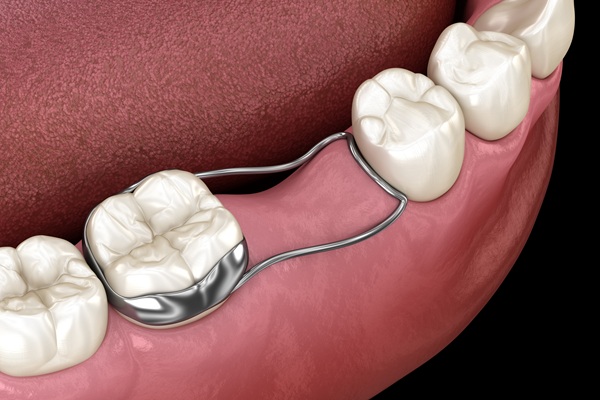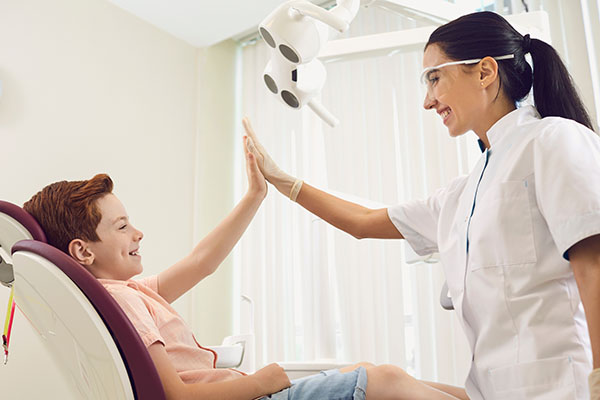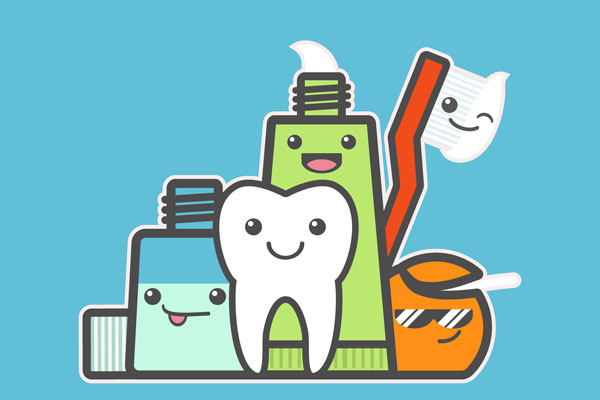Baby Root CanalNorthridge, CA
A baby root canal is a common restorative treatment that addresses various levels of tooth sensitivity in children, particularly when a cavity is near the nerve. During the procedure, the dentist removes all of the decay and carefully treats the affected nerve. Then, they place a dental crown to restore the tooth’s function and appearance.
While many people think of root canals as being for adults, saving baby teeth with a baby root canal can help prevent future oral health issues. Baby root canals are available at Kidz Dental Home in Northridge and the surrounding area. Call us at (818) 477-4083 and schedule an appointment to discuss whether this treatment is the right option for your child.
We Welcome Medi-Cal (Dental)
Prepping for a Baby Root Canal
In a consultation, a general dentist can assess the child’s tooth to see whether a baby root canal is necessary. During this appointment, parents can share their child’s medical history, give us a list of medications, and ask questions. We will review the severity of the tooth decay, as well as treatment, sedation options, and aftercare.
There are misconceptions that root canals are extremely uncomfortable, but this is not the case. The procedure is completely safe for children, generally causes little discomfort, and can relieve tooth irritation. The first thing parents can do is to stay calm and reassuring so their child will feel comfortable during the procedure.
The dentist will talk to the child and parent about the procedure and why they need it. Parents can help reinforce that message so the child understands what will happen. Telling the child that there will be medicine to keep them from feeling any sensations in the mouth during the procedure can be helpful.
Parents should talk to the dentist about different options for pain management if their child needs extensive work, is anxious, or has special health care needs. Make sure to inform the dentist of any allergies, such as to antibiotics.
“The procedure is completely safe for children, generally causes little discomfort, and can relieve tooth irritation.”
Check out what others are saying about our Baby Root Canal services on Yelp: Baby Root Canal Northridge
What To Expect From a Baby Root Canal
The general dentist will first use a local anesthetic to numb the area thoroughly during a baby root canal. After isolating the tooth, they will remove any decay and assess the health of the tooth's nerve. If the decay removal results in nerve exposure or nerve damage, they will remove the infected part of the nerve.
Next, the dentist will make sure the rest of the nerve is healthy. If it is, they will apply medicine to heal the nerve. The dentist will then build the tooth back up and cover it with a crown. The crown covers the tooth and gives it strength to keep it from fracturing later. It restores the child's tooth to its normal size, shape, and function to help it resemble the rest of the teeth.
“The crown covers the tooth and gives it strength to keep it from fracturing later.”
The Healing Process
After a baby root canal, the child should be able to return to normal activities right away. However, it is important to wait for the numbing to wear off in the mouth before eating. This pause helps prevent accidentally biting the lip or cheek and ensures that the treated area remains undisturbed.
In cases where the tooth has a severe infection, the general dentist may prescribe antibiotics. Make sure to have the child finish the entire course of antibiotics, even if they feel better before the course is complete. Otherwise, the remaining bacteria will be free to multiply and could become resistant to antibiotics.
Patients may notice mild swelling or sensitivity around the treatment area for a few days, which is manageable with a child-friendly over-the-counter pain reliever. Parents should help their children maintain regular brushing and flossing to promote healing.
“After a baby root canal, the child should be able to return to normal activities right away.”
Post-Procedure Guidelines
Following a baby root canal procedure, patients should rest and avoid any strenuous activity. A general dentist may recommend using cold compresses or mouth rinses to prevent inflammation or infection. The patient and their parents will need to go over specific instructions and any medications, such as antibiotics, with the dentist before leaving.
Although rare, it is possible to get an infection after a baby root canal. Parents should call the dentist if their child experiences increasing discomfort, new inflammation, increased tooth sensitivity to hot and cold, or an inability to chew on the tooth. These are all signs of a possible infection. Fortunately, infections are easily treated when addressed immediately.
“The patient and their parents will need to go over specific instructions and any medications, such as antibiotics, with the dentist before leaving.”
When a Baby Root Canal Is Necessary
A baby root canal and subsequent dental crown are necessary when the tooth has a large cavity or is broken. A dental filling is not durable enough to repair severely decayed or fractured teeth due to the risk of falling out, breaking, or wearing out. According to the American Academy of Pediatric Dentistry, a baby tooth with extensive decay is unlikely to be fixed with a traditional filling. However, it is possible to restore it with a custom crown.
While it may seem silly to try to repair a baby tooth, keeping these teeth healthy until they fall out on their own helps the permanent teeth grow into their proper positions. This can save on future treatment. Additionally, the enamel of baby teeth is thinner, so decay can spread more quickly between teeth. Crowns cannot only save the decayed tooth but also help prevent the spread of decay and infection to the rest of the mouth, including the child’s permanent teeth.
When damage to the tooth is less severe, a pulpotomy may be an option. This procedure removes just the damaged portion of the pulp, or all the pulp in the upper chamber of the tooth, without touching the root canals. The pulp is the interior of the tooth that contains the tooth's blood supply and nerves. The general dentist will remove the damage, stabilize the rest of the healthy pulp, and possibly seal the tooth with a crown.
However, if the pulp tissue is infected through the entire tooth, a pulpectomy, or baby root canal, is necessary. The dentist will remove all the pulp tissue from the tooth’s upper chamber and the roots, disinfect the root canals, and then fill and seal them. A crown will be used to protect the entire tooth.
Both of these procedures are approved for children and use materials designed for a child’s health and well-being. Furthermore, they offer welcome relief from tooth discomfort. Parents can go into the procedure feeling confident that it is the right decision for the oral health of their child.
“While it may seem silly to try to repair a baby tooth, keeping these teeth healthy until they fall out on their own helps the permanent teeth grow into their proper position.”
Questions Answered on This Page
Q. How can parents prepare themselves and their child before a baby root canal?
Q. What can I expect during a baby root canal?
Q. What does the healing process look like after a baby root canal?
Q. What are the post-procedure guidelines for a baby root canal?
Frequently Asked Questions
Q. Why does my child need a baby root canal?
A. When tooth decay has progressed beyond what a normal filling can address and there is a significant infection, a baby root canal may be recommended. The procedure is safe for children and will help relieve discomfort by removing the damaged portions of your child’s tooth. Not addressing the infection can lead to further complications.
Q. What happens during a baby root canal?
A. The general dentist will thoroughly numb the area and remove the diseased pulp during this procedure. Then, the chambers and canals of the tooth are disinfected and filled. Finally, the dentist covers the top of the tooth with a durable crown, which will last until the baby tooth is ready to fall out naturally.
Q. What can I expect after a baby root canal?
A. Eating should be avoided until the area is no longer numb. If the tooth was severely infected, the general dentist may prescribe antibiotics. The area around the tooth may be slightly swollen and sensitive for a few days, so an over-the-counter pain reliever designed for children can help make the child more comfortable.
Q. Is a baby root canal safe?
A. Yes, a baby root canal is a safe procedure that uses materials designed for children. It is relatively painless, and recovery time is minimal. Choosing to save a baby tooth can help prevent future oral health issues in your child.
Q. Are baby root canals covered by dental insurance?
A. As every dental plan is different, each treatment and procedure type varies in eligibility. We advise parents to check with their child’s insurance provider to fully understand what their plan entails and their coverage. This helps parents avoid unexpected issues and costs.
Dental Terminology
- Baby root canal
- A root canal performed on baby teeth to maintain the health of a primary tooth and the supporting gum tissue and bone.
- Inflammation
- A physical condition in an area of the body that becomes red, swollen, hot, and painful.
- Tooth decay
- A process in which bacteria gradually erode the tooth, leading to cavities.
- Antibiotics
- Medications that target and inhibit bacterial growth to treat and prevent infection.
- Pulpotomy
- A procedure that removes infected pulp from a tooth’s crown while preserving healthy tissue in the root.
Learn More in an Appointment
While baby teeth eventually fall out, they remain a vital component of your child’s oral health. Taking care of their baby teeth also helps with the longevity and health of their permanent teeth. If your child is experiencing tooth discomfort, call us at(818) 477-4083 to speak to a general dentist about potential treatment options.
Helpful Related Links
- American Dental Association (ADA). Glossary of Dental Clinical Terms. 2025
- American Academy of Cosmetic Dentistry® (AACD). Home Page. 2025
- WebMD. WebMD’s Oral Care Guide. 2025
About our business and website security
- Kidz Dental Home was established in 2024.
- We accept the following payment methods: American Express, Cash, Check, Discover, MasterCard, and Visa
- We serve patients from the following counties: Los Angeles County
- We serve patients from the following cities: Northridge, Los Angeles, Panorama City, Porter Ranch, Granada Hills, Reseda, Van Nuys, Sherman Oaks, North Hills, Mission Hills, Canoga Park, Winnetka, Chatsworth and Tarzana
- Norton Safe Web. View Details
- Trend Micro Site Safety Center. View Details





